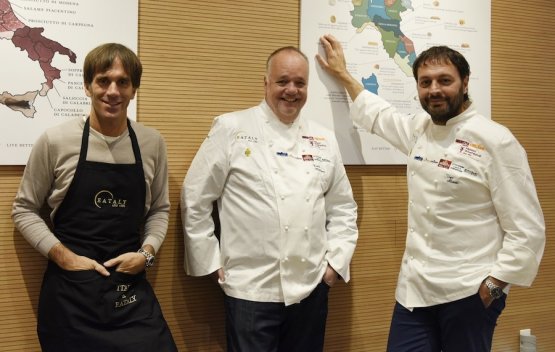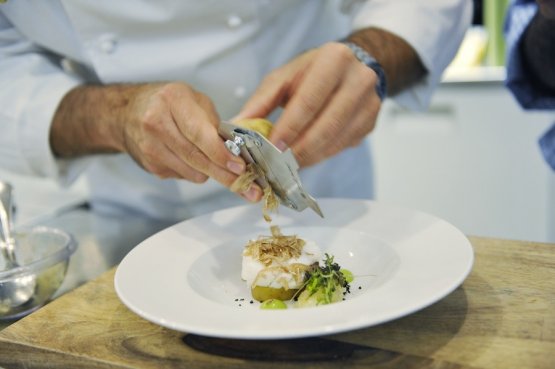Third and final day for Identità Chicago. After the tasting of Italian wines on Wednesday afternoon, Eataly’s Scuola collected the empty bottles (during the evening shift wine enthusiasts literally stormed the tasting tables) and changed the look of the room for the two cooking shows scheduled on Thursday, with Alciati and Oldani again as protagonists, respectively in pair with Tony Mantuano of Spiaggia and Lee Wolen of Boka.
For each workshop there was a very Italian gastronomic theme to be analysed from two opposite sides of the Ocean, starting with truffle. At 12 o’clock, the chef from Piedmont – the heir of one of the most important families in Italian gastronomy – opened the show by telling the audience about the time when, still 13, he used to work in the kitchen of Guido da Costigliole with his mother Lidia. Urged by Vince Gerasole of CBS, the presenter of the day, he explained how Piedmont, not having any sea, was forced to “adopt” preserved fish. Tuna and anchovies, for instance, but most of all salted codfish, which Ugo Alciati presented to the audience with potatoes and truffles, a dish that is now traditional.

Davide Oldani (left), Tony Mantuano (middle) and Ugo Alciati (right): three chefs for three Michelin stars at Identità Chicago, edition number 1
The raw materials available in Illinois are of course not the same as in the Langhe so the chef uses some codfish marinated in salt (80%) and sugar (20) in the fridge for 24 hours. Once the juice is extracted, the fish becomes firm and is left in the water for 12 more hours before it is steam cooked in the oven for 7 minutes at 176°C. The final part of the filet, instead, is used to make a tartare, simply seasoned with extra virgin olive oil, salt and pepper, served together, as well as the cooked codfish, with a parsley, oil and ice emulsion and a cream of potatoes.
When later Alciati, with the help of Mantuano, started to walk around the room with two precious specimen of white truffle from Alba, the audience began to smile like a kid in a sweetshop in front of the generous quantities of grated truffle. Not even the time of teaching the person sitting beside the perverse pleasure of dipping bread in the sauce, that the chef from Spiaggia got on stage. His is one of the few establishments in town that does honour to authentic Italian cuisine and this year has celebrated its 30th anniversary with a restyling of the dining room.

Salted codfish with soft potatoes and white truffle, a traditional dish presented by Ugo Alciati
His interpretation of fresh egg pasta is called “ravioletto” and – as he himself admits – it is not philologically correct at least for three reasons: the pasta is cooked before composing the ravioletto (which in fact is an oversize raviolo), the filling is made with crescenza cheese (produced in Dallas) and finally, and most importantly, it is gluten-free. This is not a mannerism but is based on the necessity of satisfying the ever growing demand of the celiac audience in his restaurant on Magnificent Mile, a few steps from lake Michigan.
Paired with the solitary napkin of pasta, some sautéed fresh porcini, fried with brown butter, some freshly grated Grana Padano and – of course – some more truffle. A vigorous and opulent dish, totally based on the quality of raw materials. Because – as underlined by Mantuano – “one of the things that makes Italians angrier is when people abroad lose control of the quality and the authenticity of the products from your regions”. Hardly true, in light of the endless and undisputed ransacking of our food made in Italy across the world.